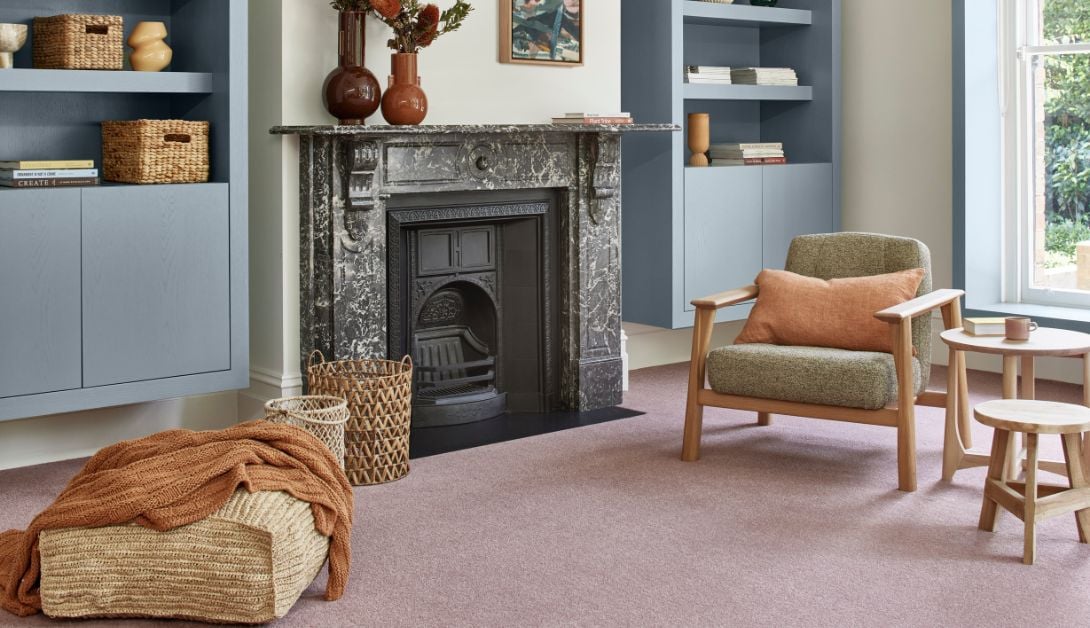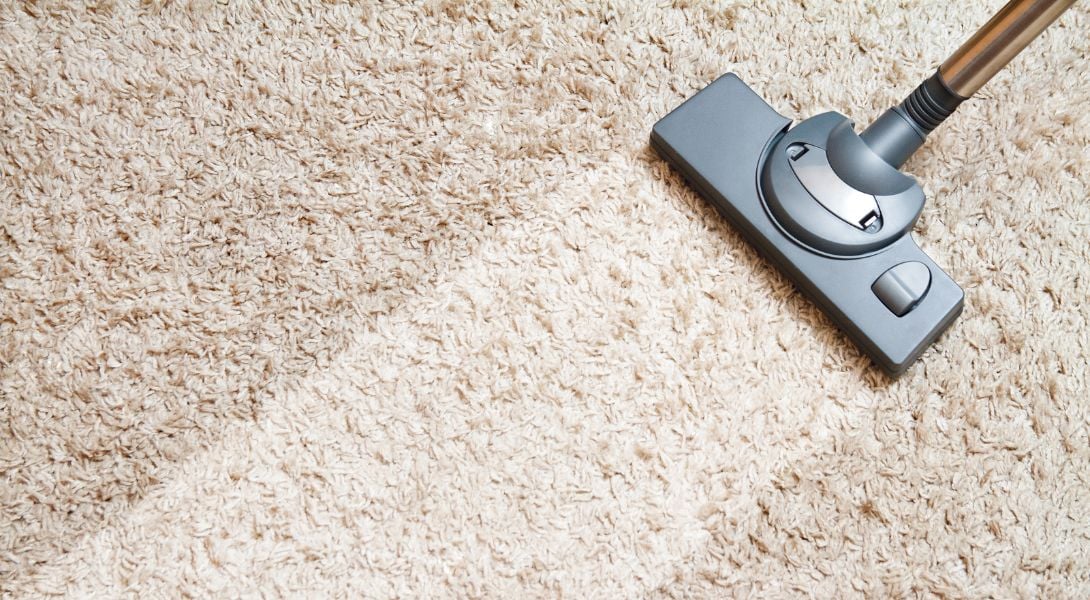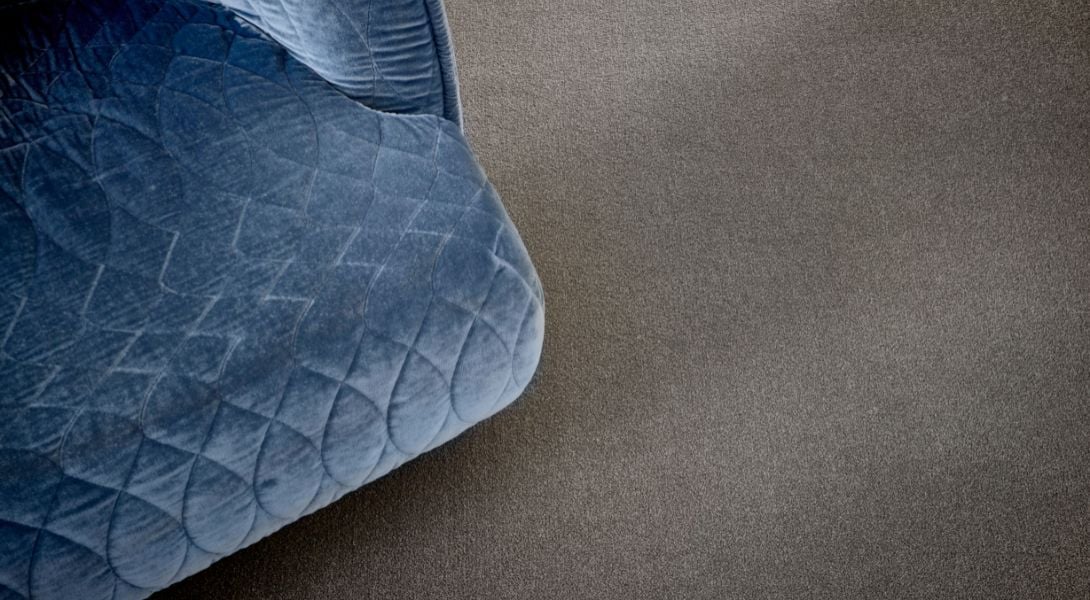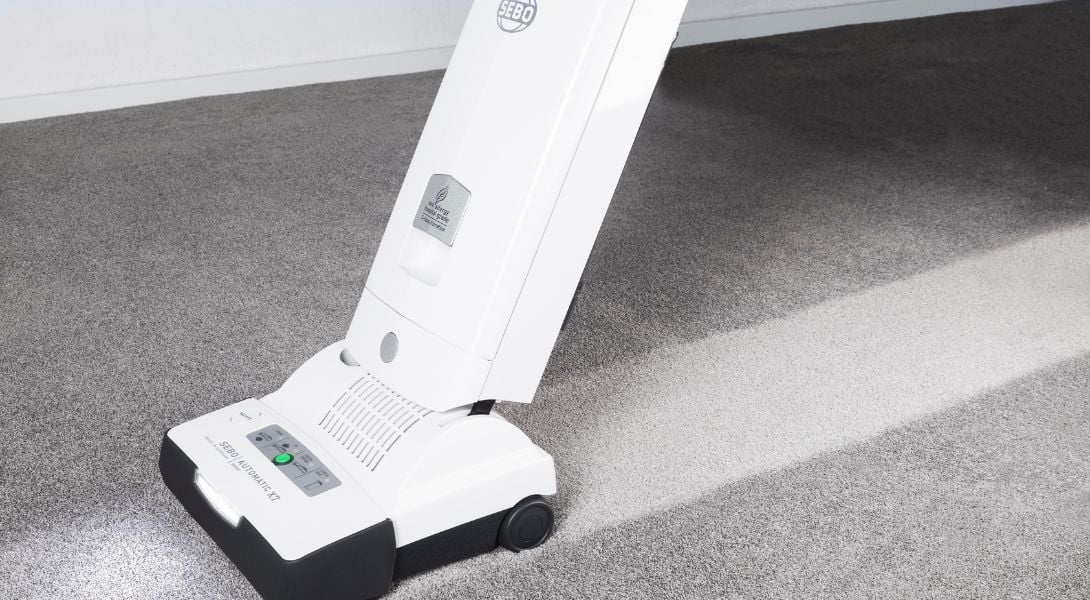How to Deep Clean and Maintain Your Carpet: A 9-Step Guide
Updated:
Published:
Approximate Reading Time: 14 minutes
We at the Floorworld blog team know too well the horrors of dealing with carpet stains, smells, sights, and sounds (of anguish when you can't get that darn red wine stain out!) It's almost too much to bear.
That's why we decided to sit down with industry veteran Helen Lazenkas from Carpets Galore Floorworld in Thomastown, Victoria, to compile this in-depth carpet care and maintenance guide to help you learn the best tips to clean and maintain your carpets.
Helen Lazenkas is a second-generation director on the Floorworld Board of Directors and has been in the flooring industry, selling, servicing, and supplying carpets since 1995. Running Carpets Galore Floorworld Thomastown, she has experience in all flooring types in the Floorworld range, including Timber, Vinyl, Hybrids, and more. She has also spearheaded Floorworld's involvement with Pancare and pushed for initiatives such as 4Women4Pancare on behalf of Floorworld.
For the full collection of flooring care and maintenance tips for all types of flooring, check out our Floorworld Essentials Article: The Complete Flooring Care and Maintenance Guide.
1. General Tips to Follow for Cleaning Your Carpets
2. How Your Carpet Type Affects Your Clean
3. How to Prepare Your Carpet Before Cleaning
4. What Products and Equipment to Use While Cleaning Carpets
5. The Step-by-Step Guide to Deep Clean Your Carpet
6. Things to Watch Out for When Cleaning Your Carpet
7. Household Considerations when Cleaning Carpet (Pets, Children, Allergies)
8. How to Protect and Maintain Your Carpet
10. Conclusion
1. General Tips to Follow for Cleaning Your Carpets
Now, before we go too deep into the rabbit hole of carpet cleaning insights, we have assembled some general tips to keep in mind. If you read nothing else in this article, just remember the tips below to extend the life of your carpets.
- Regular carpet cleaning is essential to maintain the appearance and longevity of your carpets.
- Vacuum your carpets at least once a week to remove dirt and debris.
- Use a high-quality vacuum cleaner with a rotating brush or beater bar to agitate the carpet fibres and loosen dirt (most modern vacuums have this already).
- Get to and treat spills and stains as quickly as possible to prevent them from becoming permanent.
- Avoid using excessive water when cleaning your carpets, as this can lead to mould and mildew growth.
-
Always make sure to check the carpet manufacturer's advice directly; below is a list of key suppliers' carpet care guides:
2. How Your Carpet Type Affects Your Clean
When cleaning and maintaining your carpet condition, it is essential to consider how your carpet type reacts to different cleaning methods. Some carpet fibres can respond very differently to others, and what may work for one may damage another.
To ease your worries, let's delve into the distinctions between the most common variants, including Wool, Solution-Dyed Nylon, Triexta, Polyester, and Polypropylene carpets, and how their cleaning needs vary:
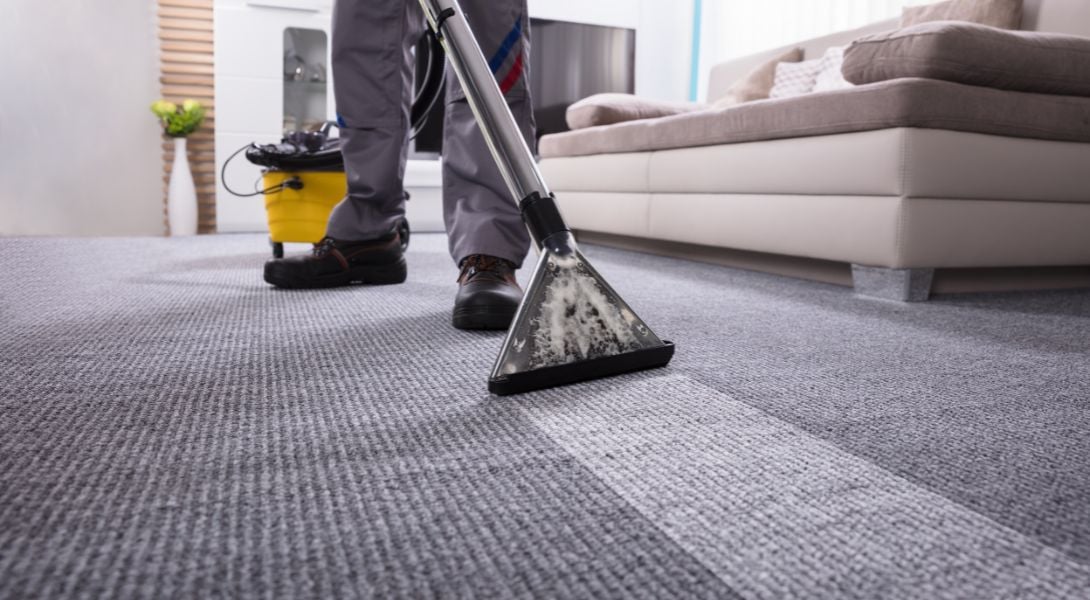
Cleaning Wool Carpet:
Wool carpet requires gentle care to preserve its integrity. Due to its absorbent nature, wool is sensitive to moisture and prone to shrinking and matting if exposed to excessive water during cleaning. Dry cleaning or low-moisture extraction cleaning are recommended to prevent damage and maintain the wool carpet's plush texture.
Cleaning Solution Dyed Nylon:
Solution-dyed Nylon is more moisture-resistant than wool and can withstand deeper cleaning methods, such as hot water extraction or steam cleaning. However, it's essential to use pH-balanced cleaning solutions to avoid discolouration or fibre damage.
Cleaning Triexta Carpet:
Like Solution Dyed Nylon, Triexta carpets can effectively tolerate steam cleaning and deep extraction methods. However, homeowners should still exercise caution with harsh chemicals or abrasive brushes to prevent fibre damage.
Cleaning Polyester Carpet:
Polyester fibres are inherently hydrophobic, repelling moisture and resisting stains; however, they can attract oily residues and soil over time. Regular vacuuming and periodic steam cleaning or shampooing are recommended to maintain the polyester carpet's appearance and longevity.
Cleaning Polypropylene Carpet:
Polypropylene (also known as Olefin) is prized for its resistance to moisture, mould, and mildew. However, its low melting point makes it susceptible to heat damage, necessitating caution when using hot water extraction methods. Polypropylene carpets prefer dry or low-temperature steam cleaning to avoid fibre distortion or colour fading.
By recognizing the unique properties of your carpets, you can tailor your cleaning approach to maximize effectiveness while safeguarding the integrity of your flooring investment.
For more information regarding different carpet types, please visit us in-store and ask one of our trained staff for more details.
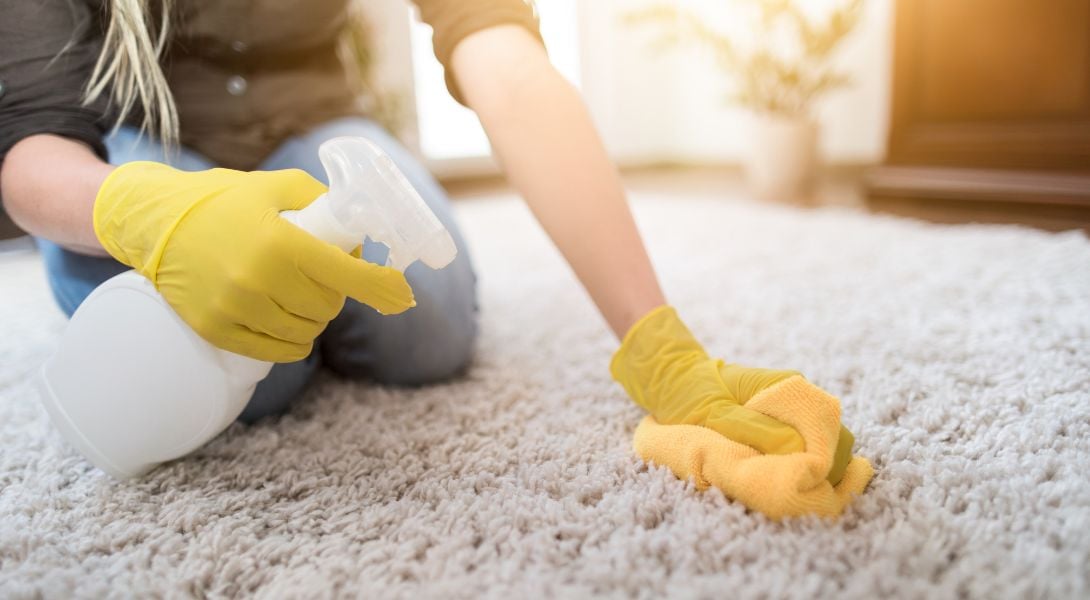
3. How to Prepare Your Carpet Before Cleaning
Before you begin cleaning your carpets, it's essential to properly prepare your floors to make sure you get the most out of your cleaning efforts without creating any further issues.
Below is a list of things to remember when preparing your floors:
- Remove any furniture or objects from the area you plan to clean.
- Vacuum the entire carpet area to remove loose dirt, debris, and other excess.
- If there are any loose or frayed carpet fibres, trim them with scissors to prevent further damage.
- Test any cleaning solutions on a small, inconspicuous area of your carpet to check for colourfastness. This is very important so as not to damage the colouring on your carpets.
- Open windows or turn on fans to ensure proper ventilation during cleaning.
- Depending on the sensitivity of any individuals or the intensity of the products used in the cleaning process, you can optionally clear out the room and provide masks to those present during the cleaning process.
Taking these steps will help ensure that your carpet cleaning process is effective and safe for your floors.
4. What Products and Equipment to Use While Cleaning Carpets
When it comes to cleaning carpets, using the right products and equipment can make all the difference. While you may not need everything for weekly cleaning, having an idea of your options can make your next carpet cleaning session much easier.
Below is a list of recommendations and options for your consideration:
- For any carpet cleaning equipment you may require for Commercial, Wool, or Synthetic (mostly everything besides wool), click the links for recommendations.
- A high-quality vacuum cleaner with a rotating brush or beater bar is essential for general carpet cleaning. Most modern vacuums already have these.
- Depending on your carpet type, consider investing in or renting a specialised carpet cleaner to suit its needs, whether steam or dry. This is especially important if you have an individual highly sensitive to allergens in the home.
- We highly recommend SEBO carpet cleaners for this, having the backing of multiple carpet suppliers.
- Depending on your carpet type, consider investing in or renting a specialised carpet cleaner to suit its needs, whether steam or dry. This is especially important if you have an individual highly sensitive to allergens in the home.
- A professional carpet stain remover or carpet shampoo can be handy for treating specific stains and spots. Make sure to check how it will affect your carpet's fibres and colouring.
- Microfiber cloths or white towels are ideal for blotting and cleaning stains without causing damage.
- Use a mild carpet cleaning solution or make your own DIY carpet cleaning solution using ingredients like white vinegar, baking soda, and warm water.
Helen's Wool Carpet Cleaner Recipe:
1 teaspoon of wool laundry detergent
Helen's Synthetic Carpet Cleaner (Usable on nylon and polyester)
1 teaspoon of white vinegar
1/2 cup of room-temperature water - Use a mild carpet cleaning solution or make your own DIY carpet cleaning solution using ingredients like white vinegar, baking soda, and warm water.
5. The Step-by-Step Guide to Deep Clean Your Carpet
After you have completed your preparations and have taken into consideration your specific carpet fibre needs, follow the provided in-depth, step-by-step guide to deep cleaning your carpets:
Step 1: Vacuum Thoroughly
Start by thoroughly using a high-quality vacuum cleaner on the carpet surface to remove loose dirt, dust, and excess. Pay special attention to high-traffic areas and corners where dirt tends to accumulate.
Step 2: Spot Treat Stains
Inspect the carpet for any visible stains or spots and treat them promptly using appropriate stain removal products. Make sure to test the cleaning solution on smaller, less visible areas of the carpet to ensure compatibility and prevent damage. Blot the stained area gently from the outside inwards with a clean, absorbent cloth to lift the stain without spreading it further.
Step 3: Choose the Cleaning Method
Select the most suitable cleaning method based on the carpet fibre type and the extent of the cleaning job required. Common cleaning methods include dry cleaning, steam cleaning (hot water extraction), and shampooing. Refer to the manufacturer's recommendations and fibre-specific guidelines (mentioned earlier in this article) to determine the optimal cleaning approach for your carpet.
Step 3.1: Dry Cleaning (Powder or Foam)
Sprinkle the dry cleaning powder or apply the foam evenly across the carpet surface, allowing it to penetrate the fibres and absorb dirt and grime. Use a carpet brush or rotary machine to agitate the cleaning agent and loosen the soil, then vacuum the area thoroughly to remove the residue.
Step 3.2: Steam Cleaning (Hot Water Extraction)
Fill the steam cleaner's reservoir with hot water and a recommended carpet cleaning solution, then follow the manufacturer's instructions for operating the machine. Slowly pass the steam cleaner over the carpet surface, applying even pressure to extract dirt, debris, and cleaning solution from the fibres.
Step 3.3: Carpet Shampooing
Dilute the carpet shampoo according to the manufacturer's instructions and apply it using a carpet shampooer or rotary machine with a shampooing brush attachment. Work the shampoo into the carpet fibres in a back-and-forth motion, then rinse thoroughly with clean water to remove any residue.
Step 4: Rinse and Dry
After cleaning, rinse the carpet thoroughly with clean water to remove any remaining cleaning solution or residue. Use a wet/dry vacuum or extraction machine to extract excess moisture from the carpet, working in small sections to ensure thorough drying.
Alternatively, if you don't have the equipment, apply water with a cloth until the carpet no longer feels sticky or soapy, then blot it up with a clean white cloth or paper towel. Then, several layers of cloth or white paper towels should be placed over the cleaned area, weighing it down to capture the remaining moisture.
-
Step 5: Air Out Your Home
Open windows or use fans to promote air circulation and expedite drying, preventing mould or mildew growth and getting rid of the cleaning agents in the air.
Step 6: Replace Furniture
Once the carpet is completely dry, replace the furniture and return the room to its original layout. Please do not walk on the carpet until fully dry to prevent re-soiling or damaging the freshly cleaned fibres.
Step 7: Regular Maintenance and Consider Professional Cleaners
To extend the longevity and quality of your carpet, you can establish a regular maintenance routine, including vacuuming at least once a week and promptly addressing spills or stains.
If a stain persists or you want a deeper cleaning, you can also consider scheduling professional carpet cleaning services.
By following the above steps, you can ensure that any stains or excesses are extensively removed from your carpet and that you can continue to enjoy it for years to come.
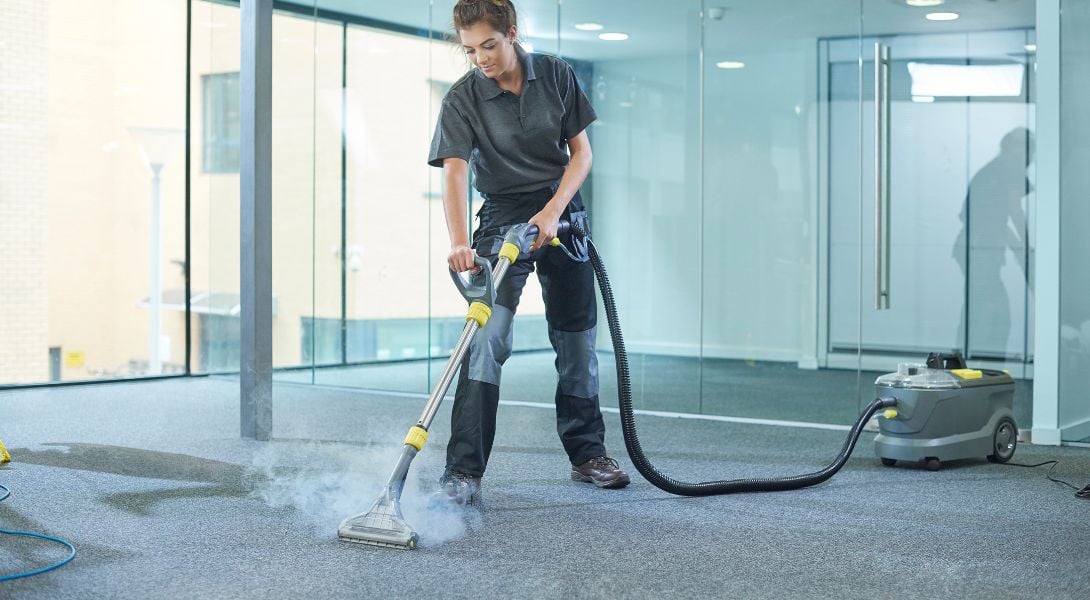
6. Things to Watch Out for When Cleaning Your Carpet
Not everyone can be an expert. While cleaning your carpet, it's important to be aware of certain factors that you may not consider to avoid damaging your floors:
Be Mindful of your Carpet Type and Fibre:
I know we keep harping on about it, but it is very important to realise that cleaning a wool carpet is very different from cleaning a synthetic nylon or triexta carpet. One method may be perfect for one type but cause damage to another.
Avoid Deep Cleaning your Carpet too Often
Deep cleaning your carpet too frequently may reduce the life of your flooring and damage the fibres. It is normally best advised to clean no more than once a year, but this can depend on factors such as high foot traffic and spills.
Be Careful Using Coloured Towels:
Using a coloured towel might transfer the colour onto the carpet; attempting a test patch before committing to a larger area is best. You can also use a white paper towel to be especially safe when transferring colour.
Avoid Using Soapy Mixtures:
Too much soap in a carpet cleaning solution will cause your carpets to attract and trap more dirt after you have completed cleaning your carpets.
Avoid Using Excessive Water:
Excess water in the carpet cleaning process can lead to overwetting and potential mould growth. This is especially important for some carpet types, such as wool, which are more easily prone to water damage.
Be Mindful of the Temperature of your water:
It is important to manage the temperature of the water in your cleaning solution, as heat may damage and fray carpet fibres. Make sure to use a warm, not hot, solution.
Be cautious when using Strong Chemical Cleaners:
Strong chemical cleaners, if used too liberally, may cause discolouration or damage to certain types of carpets. Attempting a test patch for adverse reactions before using it on your overall carpet is important.
Do Not Use Bleach
Using bleach and other general cleaning products without guidance can damage carpets. It is important to be aware and either seek guidance or use products specifically designed for carpets when cleaning your floors.
Don't Scrub or Rub too Hard
Scrubbing or rubbing your carpet too vigorously can damage the fibres and cause them to fray over time. Be gentle with your carpets and blot from the outside to avoid spreading stains to a wider area.
By being mindful of these factors, you can protect your carpet and maintain its appearance and integrity.
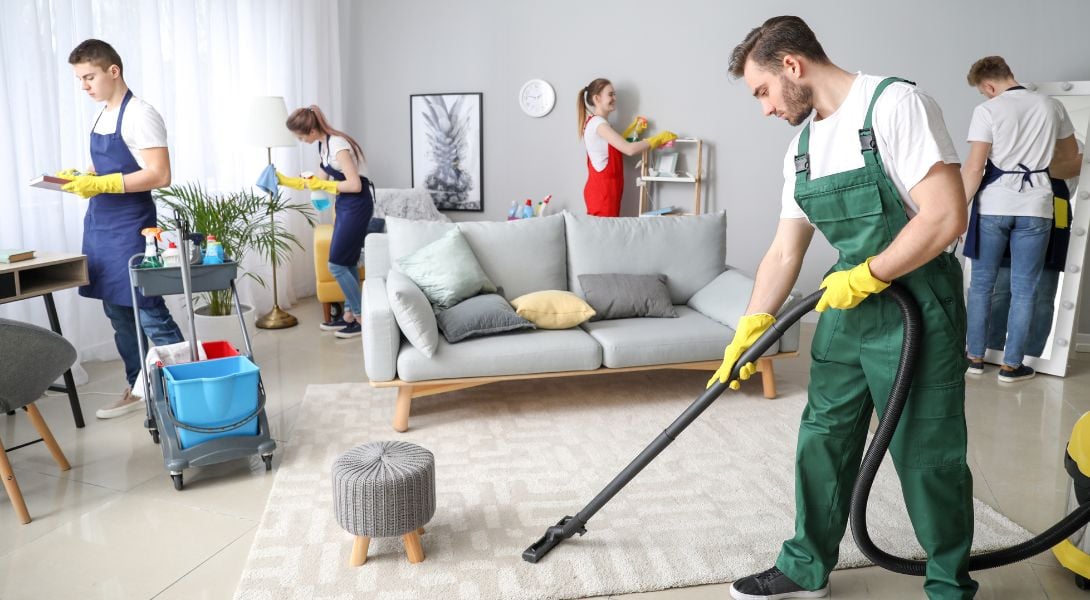
7. Household Considerations when Cleaning Carpet (Pets, Children, Allergies)
When cleaning your carpet, it's important to take into account any household members (be they human or fluffy) that may impact the cleaning process.
- If you have pets, remove them from the area being cleaned and ensure any cleaning products are safe for use around animals.
- Ensure that any cleaning products are non-toxic and child-safe for households with children. Or simply ensure they are not in contact with the carpet until the product has been cleaned off.
- If anyone in your household has allergies or sensitivities, opt for hypoallergenic carpet cleaning solutions. Consider using a carpet cleaner with a HEPA filter to trap allergens and improve indoor air quality. Ensure proper ventilation during and after cleaning.
Considering these household factors, you can ensure a safe and effective carpet cleaning process for everyone in your home.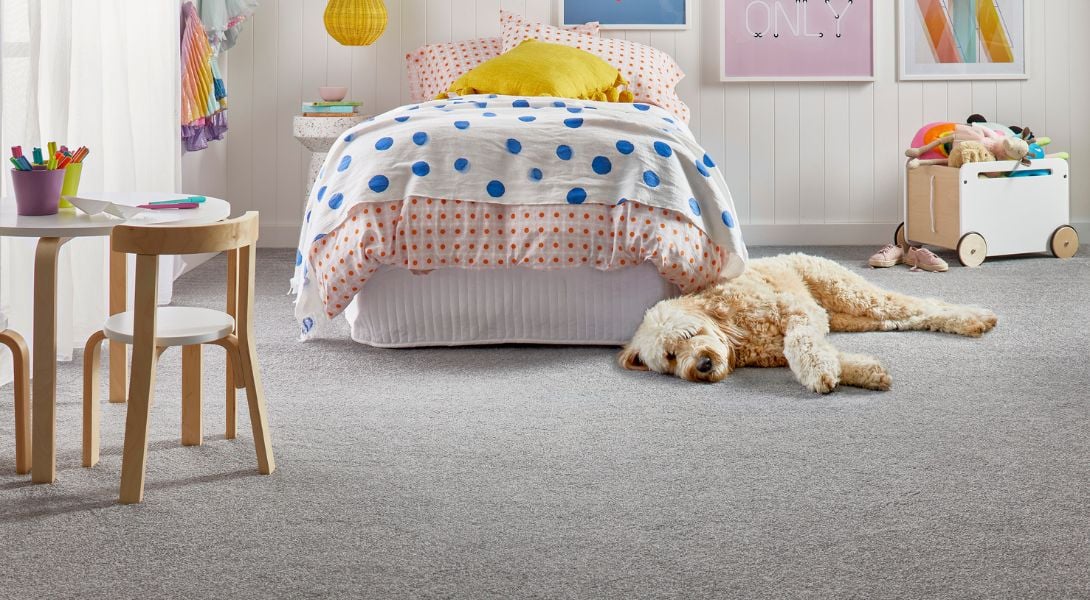
8. How to Protect and Maintain Your Carpet
Cleaning your carpets is only really half the battle; one of the most important parts of carpet care is the steps you take to protect and maintain the condition of your carpet.
Here are a few recommendations for what you can do:
- Place doormats at all entrances to trap dirt and encourage visitors to scrape off any excess to prevent it from being tracked onto your carpets.
- Use door mats and area rugs in high-traffic areas to reduce dirt and wear on your carpets.
- Use furniture coasters or pads under heavy furniture to prevent indentations and damage to the carpet fibres.
- Rotate furniture periodically to prevent uneven wear and tear on your carpets.
- Avoid exposing your carpets to direct sunlight, which can cause fading and discolouration.
- Schedule professional carpet cleaning at least once a year to deep clean and revitalize your carpets.
By implementing these measures, you can extend the lifespan of your carpets and keep them looking their best.
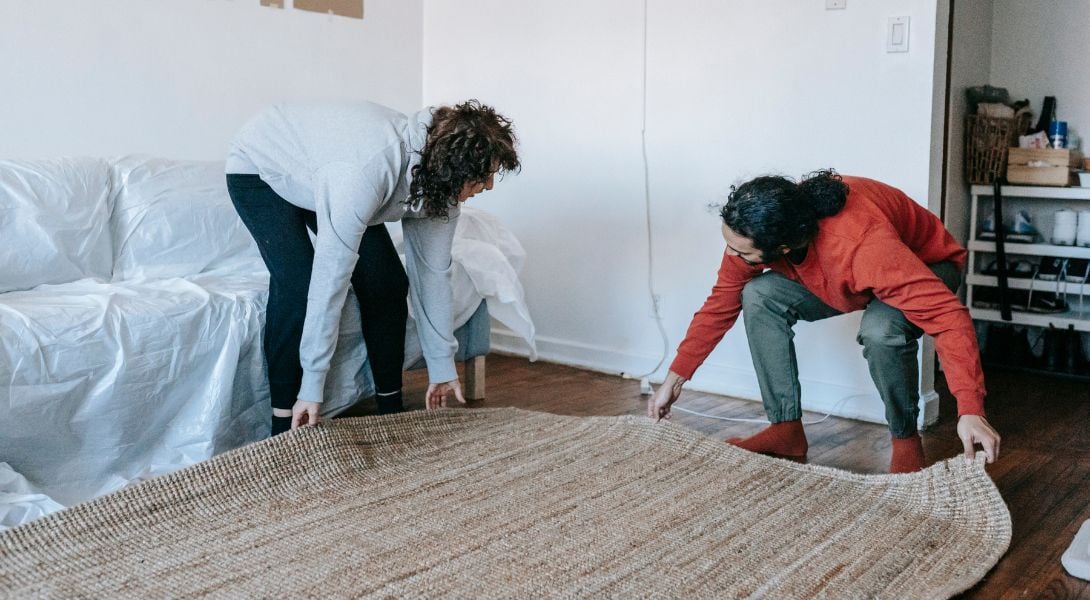
9. Carpet Cleaning FAQs
Here are answers to some common inquiries related to carpet cleaning:
How often should I have my carpets professionally cleaned?
Having your carpets professionally cleaned at least once a year is generally recommended. However, high-traffic areas or households with pets or allergies may require more frequent professional cleaning.
Can I clean my carpets myself, or should I hire a professional?
While homeowners can do regular vacuuming and spot cleaning, professional carpet cleaning can provide a deeper and more thorough cleaning, especially if previous cleaning attempts have proved insufficient. Consider hiring a professional or renting equipment for best results.
How do I get vomit out of carpet?
To remove vomit from the carpet, act quickly by blotting the area with paper towels or a clean cloth to absorb as much liquid as possible. Remove any solid chunks. Prepare a cleaning solution using one part white vinegar and two parts water, or use a commercial carpet cleaner.
Gently blot the stain with the solution, avoiding rubbing to prevent spreading. Continue blotting until the stain lifts, then rinse with water and blot dry. If the odour remains, sprinkle baking soda over the area and let it sit before vacuuming.
How do I get dog or cat poop/pee out of carpet?
To remove pet urine or feces from the carpet, start by blotting the area with paper towels or a clean cloth to absorb as much liquid as possible. If dealing with feces, carefully pick up any solid waste with gloves and dispose of it.
Prepare a cleaning solution using mild dish soap and warm water, or use a pet stain remover specifically formulated for carpets. Apply the solution to the stained area and gently blot with a clean cloth, working from the outside toward the centre to avoid spreading. Rinse with water and blot dry. For lingering odours, sprinkle baking soda over the area and let it sit before vacuuming.
How do I get older stains out of carpet?
Start by pre-treating the stain with a mixture of water and white vinegar or a commercial carpet stain remover, letting it sit for 10-15 minutes to loosen the stain. Gently scrub the area with a soft-bristled brush or sponge, careful not to damage the carpet fibres.
Blot the stain with clean, dry towels to absorb moisture, then rinse the area with water and blot again to remove any remaining cleaning solution. Allow the carpet to air dry completely, and repeat the process if necessary for stubborn stains.
How do I get blood out of carpet?
Start by blotting the stain with a clean cloth or paper towel to absorb as much of the blood as possible. Avoid rubbing, as this can spread the stain further. Next, mix a solution of cold water and mild detergent or dish soap, and apply it to the stained area. Blot the stain with the solution, working from the outside toward the centre. Continue blotting until the stain is lifted.
If the stain persists, you can try using hydrogen peroxide, but be sure to test it on a small, less visible area of the carpet first to ensure it doesn't cause damage or discolouration. Apply the hydrogen peroxide directly to the stain, let it sit for a few minutes, then blot with a clean cloth. Repeat the process as needed until the stain is removed. Finally, rinse the area with cold water and blot dry with a clean towel.
How do I get paint out of carpet?
Act swiftly by blotting excess paint with a clean cloth or paper towel. Avoid rubbing to prevent spreading the paint. Dampen the stain with warm water and blot to dilute the paint. For wet paint, you may have to use a commercial paint remover designed for carpets, following instructions and testing on a small area first.
Gently scrape off dried paint with a blunt knife, then apply a carpet cleaning solution or a mixture of mild dish soap and warm water. Blot the area to lift the paint and cleaning solution, rinsing with clean water as needed. Allow the carpet to air dry completely. Repeat the process if necessary.
How do I get wax out of carpet?
Start by letting the wax cool and harden completely. Once hardened, gently scrape off as much of the wax as possible using a butter knife or a spoon. Be careful not to damage the carpet fibres. Next, place a brown paper bag or a clean cloth over the wax stain. Gently press down on the paper bag or cloth using a warm iron on a low setting. The heat will cause the wax to melt and transfer onto the paper bag or cloth.
Continue this process, using a clean portion of the paper bag or cloth each time until all the wax is removed. If any residue remains, you can blot the area with a cloth dampened with rubbing alcohol to lift it away. Finally, clean the area with a solution of mild dish soap and warm water, then blot dry with a clean cloth.
How do I clean carpet with a machine or any equipment?
You can use a few simple household items. You can use a sweeping pan instead of vacuuming any loose debris or dirt from the carpet.
A solution of equal parts white vinegar and water in a spray bottle and a cloth or paper towel can work in place of professional cleaning liquid and equipment.
How do I get red wine out of carpet?
First, act quickly to prevent the stain from setting. Blot up as much of the wine as possible using a clean cloth or paper towel. Avoid rubbing the stain, as this can spread it further. Next, use a professional cleaning liquid or alternatively mix a solution of one tablespoon of dishwashing liquid, one tablespoon of white vinegar, and two cups of warm water.
Apply this solution to the stain and blot with a clean cloth until the stain is lifted. If the stain persists, you can try applying a paste of baking soda and water to the area and letting it sit for a few hours before vacuuming it. Repeat these steps as needed until the stain is completely removed. Finally, blot the area with a clean, damp cloth to remove any remaining cleaning solution, then allow the carpet to air dry completely.
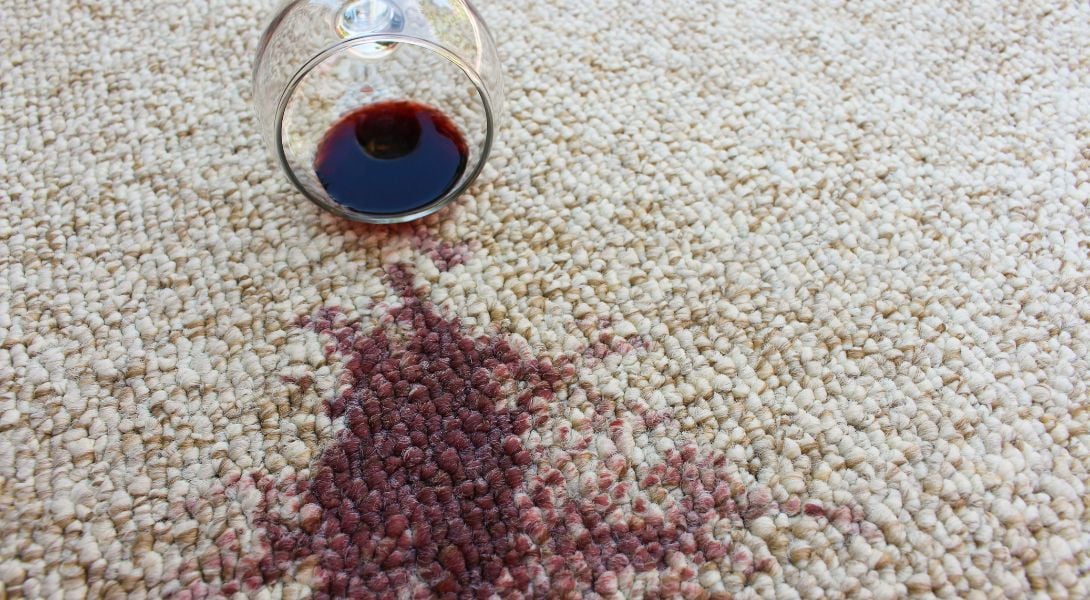
Carpet Cleaning and Care, the Conclusion
Thank you for taking the time to read our guide to cleaning and maintaining carpet flooring. Helen Lazenkas can be found at Carpets Galore Floorworld Thomastown.
For the latest trends, maintenance tips, and sustainability information, grab a copy of our e-book using the form below or view the rest of our blogs.
If you want to speak to one of our flooring experts, contact your nearest Floorworld store for more.

